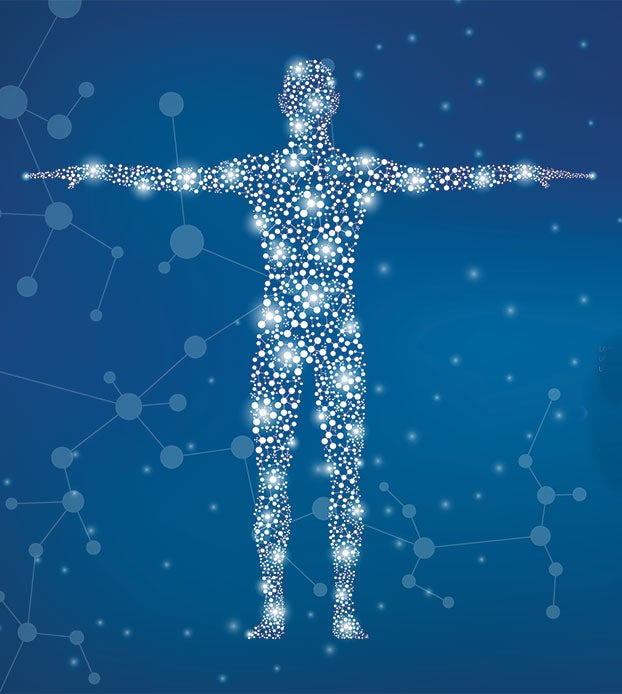If you’ve been paying attention to cannabis science, you may have heard about the endocannabinoid system and its important role in maintaining homeostasis in the human body. While often mentioned, this function is rarely explained. Still, understanding how the endocannabinoid system works to maintain balance in our body can be a big help in understanding how cannabinoid medicines might help (or in some cases worsen) different medical conditions.
So, in this article, we’ll cover the science of homeostasis and how using cannabis might affect this important function.
What is homeostasis?
The word ‘homeostasis’ comes from the Greek words homeo which means “similar” or “same,” and stasis, which means “stable.” Essentially, it refers to a state of stability, equilibrium, or balance in the body — although the term can also be applied to the internal balance of cells or other systems. In humans, maintaining homeostasis is the way our natural systems keep conditions in the body optimal for our health and well being. As conditions shift, either internally or externally, mechanisms kick into action to make sure that our body doesn’t suffer from the change. Specifically, the stimuli trigger hormones which are released into the bloodstream and then cause bodily responses which maintain this delicate balance. This is called feedback regulation and it is the basic way that homeostasis is maintained.
Take, for example, the way we adjust to changes in the temperature. The ideal for the human body is to stay around 98.6°F on average. When our body begins to heat up beyond normal temperatures, we have an automatic response — sweating to moisten our skin and bring our temperature down. Or on the other side of the spectrum, when we get cold, our bodies sweat less and less blood is circulated to the skin.
These responses are what is called negative feedback. Here negative doesn’t mean that the feedback is bad or problematic — but rather that it is an opposing response. When conditions are non-ideal, our body responds with some kind of negative feedback to bring conditions back to normal. In this case, we have a natural negative feedback loop. When temperatures get too high, they are naturally lowered, and when they get too low, they are increased. Whether reducing temperature or increasing it, negative feedback pushes the body’s temperature back towards the ideal, maintaining homeostasis.
Positive feedback regulation is another way that the body maintains homeostasis, although it is less common. With positive feedback, the direction of change is sped up, rather than reversed. For example, in lactation, the stimulation from a baby suckling causes prolactin (the hormone responsible for milk production) to be released into the bloodstream. As the baby continues to suckle, the prolactin is released proportionally.
There is a large variety of different ways in which the body maintains balance similarly to how it regulates temperature. These homeostatic actions are performed by various systems in the body such as the respiratory system, endocrine system, reproductive system, urinary system, and nervous system.
The endocannabinoid system and homeostasis
The endocannabinoid system is an important system in the human body for regulating the homeostatic activity. While it is, perhaps, best known for its ability to be stimulated by phyto-cannabinoids (the active chemicals in cannabis), it plays a key role in the body without any help from cannabis. Researchers have found that it naturally modulates a variety of different functions, such as:
- Sleep
- Pain
- Memory
- Learning
- Inflammation
- Hunger
- Energy
- Muscle control
- Temperature
- Mood
These functions occur when cannabinoids (chemicals produced naturally in our body) bind with endocannabinoid receptors (such as CB1, CB2 or TRPV-1), setting off a chain reaction that triggers these effects. Activation of this system in different ways can make us sleepy or energized, hungry or without appetite, anxious or relaxed, and so much more. Then, enzymes break down our endocannabinoids and clear them from the body.
Interestingly, this system and its effects can also be activated by the cannabinoids in cannabis. These chemicals are strikingly similar to our endocannabinoids in structure and are thus able to bind with our endocannabinoid receptors to trigger the same effects. This is why ingesting cannabinoids can lead to so many noticeable effects, such as sedation, hunger, or pain relief.
While there are many different ways in which homeostasis is modulated and maintained by the endocannabinoid system, scientists have studied a few areas more closely.
Energy homeostasis
One area of homeostasis that the endocannabinoid system has been tied to is energy homeostasis — the way our body regulates energy levels through food intake, metabolism, and energy expenditures. As regulators of metabolism, endocannabinoids are generally anabolic, meaning that they increase caloric intake, promote storage, and decrease expenditures of energy.
One way that endocannabinoids (and phyto-cannabinoids) affect energy metabolism is through influencing the appetite. Stimulating CB1 receptors with endocannabinoids like anandamide or phyto-cannabinoids like THC produces increased appetite. This should be no surprise to those who use cannabis. It’s long been known that consuming cannabis can result in an increase in appetite, sometimes referred to as “the munchies.”
In addition, blocking CB1 can produce a lack of appetite. For example, in clinical trials, CB1 was blocked by the drug rimonabant, and the result was reduced food intake and decreases in weight. The drug was eventually pulled from the market, however, due to its causing serious mood disorders.
Still, appetite regulation isn’t the only way that the endocannabinoid system regulates energy. In addition to affecting appetite, it also seems to alter our metabolism. For example, in one study, healthy volunteers smoked cannabis and had a three-day increase in caloric intake, presumably in response to increased appetite. However, after three days, the increases subsided. Despite this, subjects gained weight throughout the three-week study period — suggesting that cannabis has an effect on metabolism that goes beyond boosting appetite.
Similarly, in studies where CB1 is blocked in rodents, they are able to rapidly adjust to the appetite-suppressing effects of the treatment but continued to see weight-reducing effects. Mice naturally deficient in CB1 also tend to be leaner than their normal counterparts.
Interestingly, there is also research suggesting that stimulating CB1 can lead to weight reductions. For one thing, obesity rates are lower in cannabis users than non-users. One study found that mice given THC gained less weight on a high-fat diet than control groups. In fact, the THC seemed to alter the gut biome of the mice — transforming it from a profile consistent with obesity to one found in healthy mice.
The endocannabinoid system also seems to modulate important metabolic functions related to glucose intolerance, insulin resistance, and triglyceride and cholesterol levels. Understanding exactly how could lead to big breakthroughs for people with diabetes, obesity, and metabolic syndrome, but more research is needed to understand the complex situation.
Still, one thing is clear — the endocannabinoid system plays a big role in our energy homeostasis.
Immune response
The endocannabinoid system has also been studied for its role in maintaining immune homeostasis. Specifically, scientists have looked at the role the endocannabinoid anandamide plays in maintaining immune health in the gut. The gut’s immune system needs to be able to tolerate foreign antigens (substances that would usually stimulate an immune response) to allow for digestion, but this process is only partially understood.
Still, scientists have recently noted that anandamide contributes to this process. When anandamide is produced by the body and binds with the CB2 receptor, it causes an increase in the number of CX3CR1hi macrophages, an immunosuppressive white blood cell. By promoting immunosuppressive white blood cells like these, anandamide is able to help maintain homeostasis in the gut and pancreas — even when antigens are present. While we have a long way to go towards understanding the endocannabinoid system’s role in immune health, this demonstrates that it is at least somewhat involved in maintaining immune homeostasis.
Emotional homeostasis
Scientists have also noted that the endocannabinoid system is critical for the regulation of emotion and stress responses. For example, consider the way that cannabis use can affect anxiety and panic responses. At low doses cannabis usually induces relaxation, while at high doses it can cause anxiety, paranoia or panic. These effects are called biphasic, which means that the same substance can produce opposite effects in different conditions. Biphasic effects are common with cannabis (such as we saw with weight loss and weight gain), often in dose-dependent ways.
While CB1 stimulation can produce either relaxation or anxiety, blocking CB1 has been shown to produce severe anxiety. As we saw above in the clinical study of rimonabant, CB1 was blocked in order to suppress appetite, but doing so led to severe mood disorders like anxiety and depression.
So, importantly, in states where we see an excess of endocannabinoid signaling (such as when patients use high amounts of THC) or a deficiency of endocannabinoid signaling (such as when CB1 is blocked) our emotional homeostasis is thrown off. Thus maintaining a good balance of endocannabinoid signaling may be key to psychological health and stability.
These are just a few examples of the ways that the endocannabinoid system helps maintain homeostasis in the body, and there are many ways we haven’t covered. In addition, we have only begun to study this important topic, and as we continue to investigate it we will likely find more ways that homeostasis relies on this key system.
Cannabis’ effect on homeostasis
Now that we know that the endocannabinoid system helps support our internal homeostasis, it’s important to question what effect cannabis consumption might have on this process. After all, the cannabinoids in cannabis activate this important system in many of the same ways that natural endocannabinoids do, so are likely to cause some changes.

And indeed, the many effects of cannabis, both medicinal and adverse, show that cannabis can affect us in so many ways. In relation to maintaining homeostasis, cannabis could be a help but it could also potentially do harm.
In healthy individuals, the endocannabinoid system is already working to maintain homeostasis. So adding cannabinoids to this situation may throw off your body’s internal balance — as we saw with anxiety and weight gain in the examples above. This may be in part because excessive cannabinoid levels can also lead to a desensitization of your endocannabinoid receptors which may reduce natural endocannabinoid functioning, especially over time.
In addition, disrupting your homeostasis with cannabis can have effects you might not feel immediately, but could have big impacts. Researchers have noted that cannabis use during pregnancy can impact the homeostasis of the placenta by disrupting natural anandamide levels and related enzymes. This could lead to alterations in normal placental development and fetal growth.
It’s important to remember when dealing with the endocannabinoid system, that it is all about balance, and too much can be as bad as too little.
Of course, too little is also a problem. When endocannabinoid systems are deficient, and there isn’t enough endocannabinoid signaling, this also throws our system out of balance. A number of health conditions have recently been tied to impaired endocannabinoid functioning. According to the researchers who’ve studied this phenomenon, using cannabis could be beneficial in many of these cases — restoring endocannabinoid receptor signaling to healthy levels. In this case, cannabis use could actually help to restore balance.
If you are considering using cannabis for your own medical needs, it’s best to check with a cannabinoid-specializing doctor. They can help you to decide whether cannabis is right for your particular situation.
Sign up for bi-weekly updates, packed full of cannabis education, recipes, and tips. Your inbox will love it.

 Shop
Shop Support
Support
















